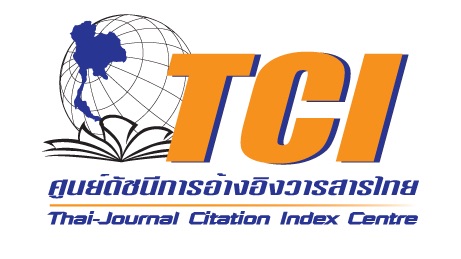Analysis of the Reflections in the Novel “PI-SAT” Written by Seni Saowaphong
Keywords:
The Novel , The Reflection of Economic, The Reflection of Cultural, The Reflection of Education, The Reflection of Social ValueAbstract
The purpose of this research was to analyze the reflections that appeared in Seni Saowaphong's novel “The Devil”. It was qualitative research by studying and analyzing the documents and the content of the novel. The research results were descriptive and analytical form. The results showed the reflections of Seni Saowaphong's novel “PI-SAT” in 4 reflections as follows 1) Occupational Issues Regarding the peasant occupation in Thailand over the civil service, it reflects that more the poor in Thailand than the rich due to the problem of peasant occupation being oppressed by the bourgeoisie. At the same time, some of the middle class that appeared in the story reflected a social image of the financial exploitation of their careers. regardless of professional ethics, there was also a matter of studying at university to use the degree for more diverse career. It also saw reflections on gender-free occupations in the modern era, and poverty issues reflected that not everyone wants to suffer from poverty, forcing some to have to work dishonestly to make themselves comfortable, and reflected that prosperity takes place in the capital. But the countryside is not taken care of, so most people must work in the capital. 2) Cultural reflections found in the story that the belief in the law of karma that appears the least in the story of Seni Saowapong's novel. The Devil in the story was a line for life that emphasizes social realities. 3) Educational reflections that appear in the story was the issue of inequality in education that included both gender inequality with little emphasis on the education of women and inequality of status that makes people's educational opportunities unequal 4) Reflections on the values that appear in the story was the issue of finding a mate that modern society has the idea of choosing a suitable for oneself. This makes it more difficult for people in modern society to have a mate, but some groups were still arranged by parents, it was the idea of the ancients that want to maintain the honor of the family. Household issues reflected that a woman must be a good wife and faithful to her husband. Racial discrimination issue found that the upper class will associate with people of the same class to maintain the honor of the family. In material values issues found that having a good image will be accepted by people in society. The author reflected that in society there was still adheres appearance and objects in order to be accepted by people in society. On the issue of gratitude, there was a reflection on the matter of gratitude for the birth. Moreover, the issue of loving the homeland the author reflects that Thai people love their homeland because besides being the place where he was born. It was also an area used to make a living as well.
References
ชิตชยางค์ ยมาภัย. (2560). ชีวิตชาวนาในสังคมร่วมสมัย: ชีวิตที่ถูกลดทอนความเป็นมนุษย์. มหาวิทยาลัยรังสิต.
ตนุภัทร โลหะพงศธร. (2563, 30 ตุลาคม). ตายสิบจะเกิดแสน แด่ ‘ปีศาจ’ ผู้ไม่มีวันตาย จากวรรณกรรมอมตะของเสนีย์ เสาวพงศ์. https://becommon.co/culture/pisat-seni-saowaphong/.
ธงชัย สมบูรณ์. (2564, 26 มิถุนายน). เงิน อำนาจ และการดำรงอยู่.http://www.edu.ru.ac.th/index.php/8-edu-information/275-2014-07-04-10-46-45
ธร ปีติดล. (2561). ‘ปีศาจ’ ความเหลื่อมล้ำ และกาลเวลา. มติชน.
ธัมนวรรณ ขอสวัสดิ์. (2562). แนวทางการประยุกต์หลักการครองเรือนของนางวิสาขาที่นำมาใช้ในสังคมไทยปัจจุบัน. มหาวิทยาลัยเซนต์จอห์น
นณริฏ พิศลยบุตร. (2559, 25 พฤษภาคม). ปัญหาความเหลื่อมล้ำทางการศึกษาของไทย: อีกหนึ่งปัญหาด้านการศึกษาที่ภาครัฐควรใส่ใจ. https://shorturl.asia/dIlcL.
ประจักษ์ ก้องกีรติ. (2548, 26 กรกฎาคม). ปีศาจของกาลเวลา : การรื้อฟื้นงานเสนีย์ เสาวพงศ์ในยุคแสวงหา. https://prachatai.com/journal/2005/07/21258.
พัทยา สายหู. (2522). ความเข้าใจเกี่ยวกับกลไกของสังคม (พิมพ์ครั้งที่ 2). โรงพิมพ์กรุงสยามการพิมพ์.
พิจิตร พงษ์เกษ. (2563). รูปแบบการครองเรือนที่พึ่งประสงค์ตามหลักธรรมทางพระพุทธศาสนาจังหวัดอุบลราชธานี. มหาวิทยาลัยมหาจุฬาลงกรณราชวิทยาลัย.
ภาวรรณ ธนาเลิศสมบูรณ์. (2564, 16 มิถุนายน). ไขรหัสความเหลื่อมล้ำการศึกษาไทย เหตุใดความช่วยเหลือไปไม่ถึงเด็ก. https://shorturl.asia/SgxoW.
มณฑา วิริยางกูร และสิริวรรณ นันทจันทูล. (2563). ภาพสะท้อนสังคมสมัยรัตนโกสินทร์ในนวนิยายอิงประวัติศาสตร์ของทมยันตี. คณะมนุษยศาสตร์, มหาวิทยาลัยเกษตรศาสตร์.
ลำไย สมอ่อน. (2541). ทัศนะทางสังคมของนักเขียนไทยจากเรื่องสั้นในวารสารสยามรัฐสัปดาห์ วิจารณ์ช่วงครึ่งทศวรรษ (พ.ศ. 2535-2539) [วิทยานิพนธ์ปริญญาการศึกษามหาบัณฑิต ไม่ได้ตีพิมพ์]. มหาวิทยาลัยมหาสารคาม.
วีระ หวังสัจจะโชค. (2563). แรงงานภาคเกษตรเป็นแรงงานเสี่ยงหรือไม่? การเปรียบเทียบคุณภาพชีวิตทางสังคมของชาวนาไทยและเวียดนาม. บัณฑิตวิทยาลัย มหาวิทยาลัยบูรพา.
วุฒินันท์ ชัยศรี. (2564). วรรณกรรมไทยก่อนและหลังได้รับอิทธิพลตะวันตก. https://elearning7.nrru.ac.th/course/view.php?id=899
สายทิพย์ นุกูลกิจ. (2543). วรรณกรรมไทยปัจจุบัน (พิมพ์ครั้งที่ 4). เอส.อาร์. พริ้นติ้ง.
สาโรช บัวศรี. (2512). พุทธศาสนากับการศึกษาแผนใหม่. คุรุสภา.
สำนักงานสถิติและดิจิตอลแห่งชาติ กระทรวงดิจิทัลเพื่อเศรษฐกิจและสังคม. (2562, 25 มีนาคม). สรุปผลการสำรวจภาวะการทำงานของประชากร. https://shorturl.asia/T37OS
สุพิศ เอื้องแซะ. (2560). ภาพสะท้อนสังคมและกลวิธีการนําเสนอเรื่องสั้นในนิตยสาร“คู่สร้างคู่สม”. บัณฑิตวิทยาลัย มหาวิทยาลัยเชียงใหม่.
เสนีย์ เสาวพงศ์. (2564). ปีศาจ (พิมพ์ครั้งที่ 7). มติชน
Downloads
Published
How to Cite
Issue
Section
License
Copyright (c) 2022 Journal of Human and Society, Sisaket Rajabhat University

This work is licensed under a Creative Commons Attribution-NonCommercial-NoDerivatives 4.0 International License.







